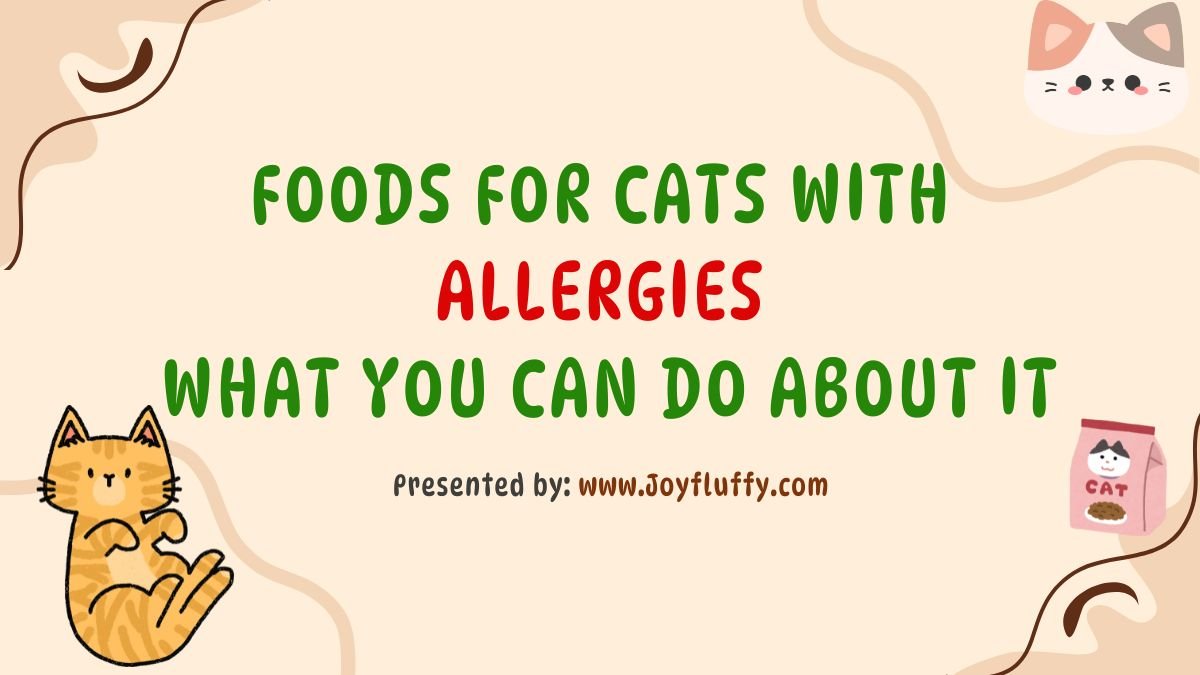Foods for Cats with Allergies: What You Can Do About It
🐱 Foods for Cats with Allergies or Food Sensitivities: What You Can Do About It
A comprehensive guide to understanding, identifying, and managing your cat’s food allergies for a healthier, happier life
If you’ve noticed your beloved feline friend scratching more than usual, developing skin irritations, or experiencing digestive troubles, you might be dealing with food allergies or sensitivities. As a concerned cat parent, watching your furry companion struggle with these issues can be heart-wrenching. The good news is that with the right knowledge and approach, you can help your cat live a comfortable, healthy life despite these challenges.
Food allergies in cats are more common than many pet owners realize. Studies suggest that approximately 10-15% of all cat allergies are food-related, making it one of the top three most prevalent allergic conditions in felines. Understanding what foods for cats with allergies work best can dramatically improve your pet’s quality of life and restore their natural vitality.
Understanding Food Allergies and Sensitivities in Cats
Before we dive into specific foods for cats with allergies, it’s essential to understand what’s happening inside your cat’s body. A food allergy occurs when your cat’s immune system mistakenly identifies a specific protein or ingredient as a threat. This triggers an immune response that manifests in various uncomfortable symptoms.
Food sensitivities, on the other hand, don’t involve the immune system but can cause similar digestive discomfort. While the distinction might seem technical, both conditions require careful dietary management and often benefit from similar food choices.
The Most Common Food Allergens in Cats
Research has identified that certain proteins trigger allergic reactions more frequently than others. The most common culprits include beef, dairy products, fish, chicken, and wheat gluten. Interestingly, these are often ingredients found in many commercial cat foods, which is why switching to specialized foods for cats with allergies becomes necessary.
Recognizing the Signs: Is Your Cat Suffering from Food Allergies?
Watch for these telltale symptoms that might indicate your cat has food allergies:
- Persistent scratching and itching: Especially around the face, ears, and neck area
- Skin problems: Including redness, rashes, hair loss, or hot spots
- Digestive issues: Such as vomiting, diarrhea, or excessive gas
- Chronic ear infections: Often recurring despite treatment
- Over-grooming: Leading to bald patches or skin damage
- Respiratory symptoms: Though less common, including sneezing or wheezing
- Behavioral changes: Irritability or restlessness due to discomfort
If you notice any combination of these symptoms persisting for more than a few weeks, it’s time to consult your veterinarian. They can help determine whether food allergies are the root cause and guide you toward appropriate foods for cats with allergies.
The Elimination Diet: Your First Step Forward
The gold standard for identifying food allergies in cats is the elimination diet trial. This process requires patience and dedication but provides invaluable insights into what’s triggering your cat’s symptoms. Here’s how it works and why it’s crucial when selecting foods for cats with allergies.
During an elimination diet, your cat will eat a novel protein source—one they’ve never consumed before—for 8-12 weeks. This timeframe allows their body to clear any previous allergens and their symptoms to resolve. Common novel proteins include venison, duck, rabbit, or kangaroo. The key is choosing proteins your cat has absolutely no previous exposure to.
Expert Tip: During the elimination diet trial, consistency is everything. Even a single treat containing the old ingredients can compromise the entire process. This means no table scraps, no flavored medications, and no sneaking treats when those big eyes are pleading!
The Reintroduction Phase
Once your cat’s symptoms have cleared on the elimination diet, you’ll systematically reintroduce old proteins one at a time. This helps pinpoint exactly which ingredients cause problems. Each protein should be tested for at least two weeks while monitoring for any symptom recurrence. This methodical approach ensures you accurately identify problematic ingredients and can confidently select safe foods for cats with allergies going forward.
Best Foods for Cats with Allergies: Commercial Options
The pet food industry has responded to the growing awareness of food allergies by developing specialized formulas. When shopping for foods for cats with allergies, you’ll encounter several categories of products designed to minimize allergic reactions.
Limited Ingredient Diets (LID)
These formulas contain a minimal number of carefully selected ingredients, making it easier to identify and avoid allergens. They typically feature one novel protein source and one carbohydrate source.
Hydrolyzed Protein Diets
These therapeutic foods contain proteins broken down into tiny molecules too small to trigger immune responses. They’re highly effective foods for cats with allergies but require a veterinary prescription.
Novel Protein Formulas
Featuring unusual protein sources like venison, duck, rabbit, or even kangaroo, these foods work well for cats who’ve developed allergies to common proteins.
Grain-Free Options
While not all cats are grain-sensitive, grain-free formulas can benefit those allergic to wheat, corn, or other grains commonly found in cat food.
What to Look for on Food Labels
Becoming a savvy label reader is crucial when selecting foods for cats with allergies. Look for products that clearly list all ingredients and avoid those with vague terms like “meat by-products” or “animal digest.” High-quality foods will specify exactly which proteins and carbohydrates they contain.
Additionally, check for artificial additives, colors, and preservatives, which can sometimes trigger sensitivities. The ingredient list should be short and recognizable. If you can’t pronounce an ingredient or don’t know what it is, research it before feeding it to your allergic cat.
Homemade Foods for Cats with Allergies: Pros and Considerations
Some cat owners prefer preparing homemade meals to have complete control over ingredients. While this can be an excellent option for foods for cats with allergies, it requires careful planning to ensure nutritional completeness.
Important: Cats have specific nutritional requirements that differ significantly from humans or even dogs. Simply cooking meat and vegetables won’t provide complete nutrition. Any homemade diet must include appropriate supplements to prevent serious health problems like taurine deficiency, which can lead to heart disease and blindness.
If you’re interested in preparing homemade foods for cats with allergies, work closely with a veterinary nutritionist. They can formulate balanced recipes using novel proteins your cat tolerates while ensuring all nutritional needs are met. Common homemade diet bases include rabbit, duck, or turkey combined with appropriate vegetables, supplements, and sometimes rice or sweet potato if your cat tolerates carbohydrates.
Raw Food Diets: A Controversial Option
Raw food diets have gained popularity among some pet owners as foods for cats with allergies. Proponents argue that raw diets are more natural and easier to digest. However, veterinary organizations have concerns about bacterial contamination and nutritional balance.
If you’re considering a raw diet for your allergic cat, discuss it thoroughly with your veterinarian. If you proceed, source high-quality ingredients from reputable suppliers, follow strict food safety protocols, and ensure the diet is nutritionally complete. Never feed raw food to cats with compromised immune systems, and always wash your hands and surfaces thoroughly after handling raw meat.
Transitioning to New Foods for Cats with Allergies
When you’ve identified safe foods for cats with allergies, proper transition is crucial to avoid digestive upset. Cats are creatures of habit, and sudden dietary changes can cause vomiting, diarrhea, or food refusal even when the new food is superior.
Start by mixing a small amount of the new food with your cat’s current diet—about 25% new food to 75% old food. Over 7-10 days, gradually increase the proportion of new food while decreasing the old. By day 10, your cat should be eating 100% of the new food. If your cat shows any signs of digestive distress, slow down the transition process.
Pro Tip: Some picky cats may resist new foods for cats with allergies, especially if they’re used to more flavorful options. Try warming the food slightly to enhance its aroma, adding a small amount of low-sodium chicken broth (if chicken isn’t an allergen), or mixing in a tiny bit of tuna water to make it more appealing.
Beyond the Bowl: Additional Management Strategies
Successfully managing food allergies extends beyond simply choosing the right foods for cats with allergies. Your entire household needs to be on board with maintaining your cat’s special diet.
Environmental Considerations
If you have multiple cats, feeding them separately prevents your allergic cat from sneaking bites of incompatible food. Consider feeding in different rooms or using timed feeders. Also, secure trash cans and keep counters clear of human food that might tempt your cat.
Communicate with family members, roommates, and visitors about your cat’s dietary restrictions. Well-meaning guests might not realize that “just one treat” could trigger days of discomfort for your feline friend.
Medication and Treats
Many medications come in flavored formulations that might contain allergenic ingredients. Always check with your veterinarian about unflavored alternatives or formulations that won’t interfere with your cat’s specialized diet. Similarly, treats designed as foods for cats with allergies are available—look for single-ingredient freeze-dried meat treats using novel proteins your cat tolerates.
The Role of Omega-3 Fatty Acids
While not foods for cats with allergies per se, omega-3 fatty acid supplements can significantly benefit cats with allergic skin conditions. These anti-inflammatory compounds help reduce itching, improve coat quality, and support skin barrier function.
Fish oil is a common omega-3 source, but if your cat is allergic to fish, alternatives like algae-based supplements provide similar benefits. Always choose supplements specifically formulated for cats, as human supplements may contain ingredients harmful to felines or be present in incorrect dosages.
Related Articles You Might Find Helpful
🍎 Safe Human Foods Cats Can Enjoy as Treats – Learn which people foods are safe alternatives
⚠️ Dangerous Foods Cats Should Never Eat – Critical information about toxic foods to avoid
Working with Your Veterinarian
Your veterinarian is your most valuable partner in managing your cat’s food allergies. They can prescribe therapeutic foods for cats with allergies, recommend appropriate supplements, and monitor your cat’s progress through regular check-ups.
Keep detailed records of your cat’s symptoms, diet changes, and responses to different foods. This information helps your veterinarian make informed decisions about your cat’s care. If you’re not seeing improvement with one approach, don’t hesitate to discuss alternative options.
Some cats benefit from additional testing like intradermal allergy testing or serum allergy testing, though these are more commonly used for environmental allergies than food allergies. Your veterinarian can help determine if such testing would benefit your specific situation.
Long-Term Management and Quality of Life
Managing food allergies is a lifelong commitment, but the rewards are immeasurable. With appropriate foods for cats with allergies and consistent management, most allergic cats can live completely normal, happy lives.
You’ll likely notice dramatic improvements once you’ve identified and eliminated problematic ingredients. Scratching decreases, skin heals, digestive issues resolve, and your cat’s overall demeanor brightens. Many owners report that their cats become more playful and affectionate once they’re no longer dealing with constant discomfort.
Success Indicators to Watch For
Within 6-8 weeks on appropriate foods for cats with allergies, you should see noticeable improvements in symptoms. Skin irritation should decrease, scratching should lessen, and digestive issues should stabilize. If you’re not seeing these improvements, consult your veterinarian—the diagnosis might need revision, or you might not have fully eliminated all allergens.
Cost Considerations and Practical Tips
Specialized foods for cats with allergies typically cost more than standard cat food, which can strain budgets. However, consider this investment in perspective: the cost of repeated veterinary visits for skin infections, medications for chronic conditions, and your cat’s suffering far exceeds the price difference in food.
To manage costs, buy in bulk when possible, watch for sales on your cat’s specific formula, and consider subscribing to auto-ship programs that often offer discounts. Some pet insurance policies cover prescription diets when they’re medically necessary, so check your policy details.
Avoiding Cross-Contamination
Store foods for cats with allergies separately from other pet foods to prevent cross-contamination. Use dedicated bowls, scoops, and storage containers. Wash food bowls thoroughly between meals, as residue from previous foods can trigger reactions in highly sensitive cats.
Special Situations: Kittens, Senior Cats, and Multiple Health Issues
Managing food allergies becomes more complex when your cat has additional health concerns or falls into special life stages.
Kittens with Food Allergies
Kittens can develop food allergies too, though they’re less common than in adult cats. If your kitten needs foods for cats with allergies, ensure the formula supports growth. Kittens have higher protein and calorie requirements than adults, so work with your veterinarian to find an appropriate hypoallergenic kitten formula or create a balanced homemade diet.
Senior Cats with Allergies
Older cats often have concurrent health issues like kidney disease, diabetes, or hyperthyroidism that require dietary management. Finding foods for cats with allergies that also address these conditions can be challenging. Your veterinarian might recommend a custom-formulated diet or combine elements from different therapeutic diets under careful monitoring.
The Psychological Impact: Stress and Allergies
Interestingly, stress can exacerbate allergy symptoms in cats. Major life changes, new pets, moving homes, or changes in routine can worsen allergic reactions even when diet remains constant. When managing foods for cats with allergies, also consider your cat’s emotional wellbeing.
Provide consistent routines, safe spaces, environmental enrichment, and plenty of affection. Pheromone diffusers can help reduce anxiety in stress-prone cats. Some cats benefit from anxiety-reducing supplements, though always check that these don’t contain ingredients your cat is allergic to.
Emerging Options and Future Developments
The field of veterinary nutrition continues evolving, bringing new options for foods for cats with allergies. Researchers are developing innovative solutions including insect-based proteins, which are highly digestible and rarely cause allergic reactions, single-cell proteins grown in laboratories that eliminate common allergens, and advanced hydrolyzation techniques that make therapeutic diets more palatable.
Stay informed about new developments by following reputable veterinary nutrition sources and discussing options with your veterinarian during regular check-ups. For current information about feline nutrition and food allergies, the PetMD website offers regularly updated articles reviewed by veterinarians.
Real-Life Success Stories: Hope for Your Journey
Many cat owners have successfully navigated the challenge of finding appropriate foods for cats with allergies. The journey requires patience—most cats don’t improve overnight—but the transformation is worth the effort. Cats who were once miserable with constant itching become content companions again. Owners who worried endlessly about their pet’s health find peace knowing they’ve identified and solved the problem.
Your dedication to finding the right foods for cats with allergies demonstrates your commitment to your feline friend’s wellbeing. With persistence, veterinary guidance, and the information in this comprehensive guide, you’re well-equipped to help your cat thrive despite food allergies.
Ready to Take the Next Step?
If you suspect your cat has food allergies, don’t wait. Schedule an appointment with your veterinarian to begin the diagnostic process. The sooner you identify problematic ingredients and transition to appropriate foods for cats with allergies, the sooner your beloved companion can return to comfortable, happy living. Your cat depends on you to be their advocate and healthcare decision-maker—and with the knowledge you’ve gained here, you’re prepared for that responsibility.
Final Thoughts
Managing food allergies in cats requires dedication, patience, and often some trial and error. However, the payoff—a healthy, comfortable, thriving cat—makes every challenge worthwhile. By understanding what foods for cats with allergies work best, recognizing symptoms early, working closely with your veterinarian, and maintaining consistency in dietary management, you can give your allergic cat an excellent quality of life.
Remember that every cat is unique, and what works for one might not work for another. Stay patient during the diagnostic process, keep detailed records, and don’t hesitate to adjust strategies under veterinary guidance. Your cat’s health journey is ongoing, but with proper management, food allergies don’t have to define or limit their life. With the right foods for cats with allergies and your loving care, your feline friend can enjoy many happy, healthy years by your side.
For additional guidance on what foods are safe and beneficial for your cat beyond allergy management, explore ASPCA’s comprehensive cat nutrition tips to ensure your cat receives optimal nutrition while managing their special dietary needs.



